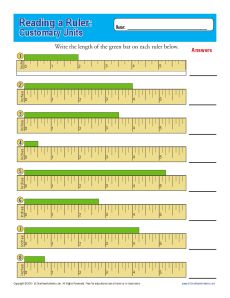
- #Free ruler learning activity how to
- #Free ruler learning activity download
- #Free ruler learning activity free
- #Free ruler learning activity windows
#Free ruler learning activity free
However, it would help us out if you liked us on our Facebook page and subscribed to our Youtube Channel.Have you used Study Jams before? It's a free video library from Scholastic with short animated clips teaching math and science concepts - and there is a whole section devoted to measurement! When I taught measurement, I used their " units of measurement" video to introduce the difference between the customary and metric systems. We aren’t collecting emails for our resources. Handout(s): 13 – Small tool, great distances
#Free ruler learning activity download
If you want a copy of our unit conversion activity, please click the link below to download a copy.
#Free ruler learning activity how to
Because, at the end of the day, we want students to learn how to problem solve – not just learn formulas. Having students document their process will show which students need help and which students have a firm grasp. Our unit conversion lab is an activity that uses simple tools to solve a seemingly difficult problem.

How do you check student understanding? How do you know students are using the tools you are teaching them? We need to ask them to explain themselves, to tell us not just what they know, but how they know it. I had them clarify and show their reasoning in greater detail. One group of students in my class wrote “By visual inspection” for their documentation. It is not good enough to just provide the answer.
#Free ruler learning activity windows
Since windows in a building are usually the same, students can measure the height of the window they are peering through. However, the previous method of breaking down the side of the building into measurable parts and then adding up those parts can be used in this question. They are not allowed to go up to the building and touch it). Those who did not write down their conversions I was able to speak with.įinding the height of the school is a little more difficult since students are only allowed to view the side of the building from my windows (ie. That’s exactly what this exercise is meant to practice: the use of unit conversions in real life. My stronger students not only know to count tiles but also document their conversions from tiles to cm in the space provided. They learn to break down a length into smaller parts that can then be counted and summed up to find the total length. They normally measure the length of a single tile and then count how many tiles stretch down the hallway. For example, using only a 30cm ruler, students find the distance down a hallway (or around our wing of the school) and the height of the school building (by observing the building from a distance).įinding the length of a hallway is usually pretty easy for students. In our measuring lab, students need to find the lengths of different distances using just a regular, 30-cm ruler.

If you want a copy of the of this activity, you can download it at the end of this post. This change – providing some extra space to write down an explanation – allowed me to see who was thinking about the problem and who was struggling (or just being lazy about their explanations). In fact, some of the best explanations tend to include all three. The explanation can be in words and can also include sketches and calculations.

To check student understanding, students had to not just give me their answer but explain how they got their answer in the extra space provided. However, my ah-ha moment only came recently, when I changed a small Measuring activity I normally do when teaching students to use unit conversions in real life. The answer is simple: we ask students to document their process when they are solving an open-ended, complex problem. Using Simple Tools, Complex tasks to Check Student Understanding So, how do we check student understanding? We can teach students how to solve a particular problem, how to set up a question, but unless students are actually using the scaffolds we provide for them, they aren’t really using what we are giving them. What if the answer is wrong? How, then, can I help the student if I don’t even know where the problem is? For a student to just get an answer to a question is not enough. As a teacher, it’s important for me to check student understanding, to know how a student is getting an answer to a question.


 0 kommentar(er)
0 kommentar(er)
